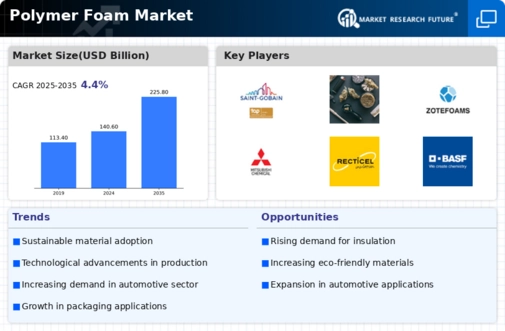Top Industry Leaders in the Polymer Foam Market

Polymer Foam Market
Polymer foam, might seem light and fluffy, but beneath the surface lies a competitive landscape as buoyant as the bubbles themselves. From cushioning our mattresses to insulating our homes and packaging our consumer goods, polymer foam finds its way into diverse applications, playing a crucial role in comfort, safety, and convenience. But navigating this airy arena requires strategic finesse, as established players and innovative startups battle for market share amidst evolving trends and technological advancements.
Strategies Inflating Market Share:
-
Product Diversification: Leading players like Dow Chemical, BASF, and Sekisui Chemical are constantly expanding their offerings, developing specialized foams with tailored functionalities for specific applications. Think flame-retardant foams for aircraft seats, high-resilience foams for sports equipment, and bio-based foams for eco-conscious consumers. -
Vertical Integration: Securing reliable sources of key raw materials like polyols and blowing agents is crucial. Companies like Huntsman Corporation and LyondellBasell are investing in backward integration to gain control over the supply chain and optimize costs. -
Focus on Sustainability: Environmental consciousness is shaping the market. Players are adopting greener production processes, using recycled materials, and developing biodegradable or compostable foam alternatives to minimize environmental impact and cater to sustainability-driven customers. -
Geographical Expansion: Emerging economies in Asia and Africa present immense growth potential, driven by rising disposable incomes and increasing demand for comfortable furniture, efficient insulation, and protective packaging. Companies like Shin-Etsu Chemical and LG Chem are establishing production facilities and forging partnerships in these regions to capitalize on this trend.
Factors Shaping the Market Mosaic:
-
End-User Industries: Construction and furniture remain the primary drivers, consuming over 50% of global polymer foam production. Growing urbanization and rising living standards contribute to this demand. -
Regulation and Safety: Stringent regulations on fire safety, chemical emissions, and food contact materials, like REACH in Europe and CPSIA in the US, drive the development of safer and compliant foam formulations. Companies meeting these standards gain a competitive edge. -
Consumer Preferences: Growing demand for comfort, convenience, and sustainability fuels the adoption of specialized foams offering enhanced comfort, noise reduction, and eco-friendly attributes. Think memory foams for mattresses, acoustic foams for studios, and plant-based packaging materials. -
Technological Advancements: Research and development efforts are leading to novel foaming technologies, improved fire retardant additives, and advancements in recycling and biofabrication techniques. Early adopters and innovators stand to benefit significantly from these advancements.
Key Companies in the Polymer Foam market includes
- BASF SE
- Armacell International S.A.
- Toray Industries, Inc.
- Borealis AG
- Recticel NV
- Polymer Technologies, Inc.
- Rogers Corporation
- Arkema S.A.
- Covestro
- SABIC
- Synthos S.A.
- Zotefoams
Recent Developments
September 2022: Covestro announced the introduction of sustainable polyether polyols based on bio-circular raw materials.
In the year 2021, Braskem, the largest polyolefin producer in the Americas and a pioneering world leader in industrial-scale biopolymer manufacturing, will announce a cooperation with Gelmart International ("Gelmart"), one of the world's largest underwear producers. Braskem is delivering its I'm greenTM EVA biopolymer, derived from sustainably cultivated sugarcane, for the creation of the world's first bra cup constructed from renewable materials
In September 2023, Covestro and Polish company Selena Group joined forces to develop a more sustainable type of polyurethane (PU) foam for better building thermal insulation. It is an ISSC Plus certified product containing plant-based feedstock by mass balancing method, which results in about 60% less carbon footprint compared to its fossil fuel-based counterparts.
In June 2022, Covestro developed a new technology that involves chemical recycling of used mattress PU foams. Polyols are valuable components for mattress foam production, and the most important isocyanate TDI can be found in these kinds of foams. The process removes this precursor from TDI so that both raw materials will be used again after reprocessing for a new formulation. At present, promising results obtained are being checked at a pilot plant located at the Leverkusen site. Thus, Covestro, together with partners from the chemical industry, wants to push through this project, establishing efficient recycling cycles.
In June 2022, Desktop Metal (NYSE: DM), the global leader among additive manufacturing companies focused on serial production, announced FreeFoam™ – a new family of photopolymer resins for the production of durable closed-cell foam parts with high dimensional accuracy without tooling; it will provide new opportunities in such industries as automotive, furniture, shoes, sports equipment, and medical devices.
In June 2022, a renowned manufacturer of hotends, nozzles, and extruders for 3D printing – E3D, announced the purchase of ZODIAC. With this acquisition, E3D has taken over all the assets and intellectual property rights of the nozzle and aftermarket FDM solutions provider.

